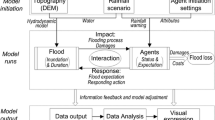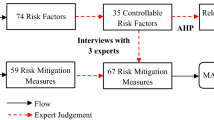Abstract
Effective flood incident management (FIM) requires successful operation of complex, interacting human and technological systems. A dynamic agent-based model of FIM processes has been developed to provide new insights which can be used for policy analysis and other practical applications. The model integrates remotely sensed information on topography, buildings and road networks with empirical survey data to fit characteristics of specific communities. The multiagent simulation has been coupled with a hydrodynamic model to estimate the vulnerability of individuals to flooding under different storm surge conditions, defence breach scenarios, flood warning times and evacuation strategies. A case study in the coastal town of Towyn in the United Kingdom has demonstrated the capacity of the model to analyse the risks of flooding to people, support flood emergency planning and appraise the benefits of flood incident management measures.












Similar content being viewed by others
References
Abt SR, Whittler RJ, Taylor A, Love DJ (1989) Human stability in a high flood hazard zone. Water Resour Bull 25(4):881–890
Axelrod R (1997) The complexity of cooperation: agent-based models of competition and collaboration. Princeton University Press, Princeton
Bates PD, De Roo APJ (2000) A simple raster-based model for floodplain inundation. J Hydrol 236:54–77
Bates PD, Dawson RJ, Hall JW, Horritt MS, Nicholls RJ, Wicks J, Hassane MAAM (2005) Simplified two-dimensional modelling of coastal flooding for risk assessment and planning. Coast Eng 52(9):793–810
BMRB (2001a) Flood warning dissemination: post event survey. British Market Research Bureau
BMRB (2001b) Flood action 2001: campaign evaluation. British Market Research Bureau
Dawson RJ, Hall JW (2006) Adaptive importance sampling for risk analysis of complex infrastructure systems. Proc R Soc A 462(2075):3343–3362
Dawson RJ, Dickson ME, Nicholls RJ, Hall JW, Walkden MJA, Stansby P, Mokrech M, Richards J, Zhou J, Milligan J, Jordan A, Pearson S, Rees J, Bates P, Koukoulas S, Watkinson A (2009) Integrated analysis of risks of coastal flooding and cliff erosion under scenarios of long term change. Clim Change 95:249–288
Dechter R, Pearl J (1985) Generalized best-first search strategies and the optimality of A*. J ACM 32(3):505–536
DEFRA and Environment Agency (2003) Flood risks to people phase 1: R&D Technical Report FD2317. DEFRA, London
Dijkstra EW (1959) A note on two problems in connexion with graphs. Numerische Mathematik 1:269–271
Environment Agency (2004) Exercise Triton 04: Overview report of lessons identified. Environment Agency, Bristol
Environment Agency (2006) Risk assessment for flood incident management: Annex 4 Understanding and application of complex system risk assessment models. Science Report—11206/SR. Environment Agency, Bristol
Estrela T, Quintas L (1994) Use of GIS in the modelling of flows on floodplains. In: White HR, Watts J (eds) Proceedings of 2nd international conference on river flood hydraulics. Wiley, Chichester, pp 177–189
Evans E, Ashley R, Hall J, Penning-Rowsell E, Saul A, Sayers P, Thorne C, Watkinson A (2004) Foresight: future flooding. scientific summary, vol 1 and 2. Office of Science and Technology, London
Galea E, Owen E, Lawrence P (1996) The EXODUS model, Fire Eng J (July 1996):26–30
Gilbert N, Troitzsch K (2005) Simulation for the social scientist, 2nd edn. Open University Press, Milton Keynes
Hall JW, Meadowcroft IC, Sayers PB, Bramley ME (2003a) Integrated flood risk management in England and Wales. Nat Hazards Rev ASCE 4(3):126–135
Hall JW, Dawson RJ, Sayers PB, Rosu C, Chatterton JB, Deakin R (2003b) A methodology for national-scale flood risk assessment. Water Marit Eng ICE 156(3):235–247
Hart PE, Nilsson NJ, Raphael B (1968) A formal basis for the heuristic determination of minimum cost paths. IEEE Trans Syst Sci Cybern 4(2):100–107
Helbing D, Farkas I, Vicsek T (2000) Simulating dynamical features of escape panic. Nature 407:487–490
Hobeika AG, Jamei B (1985) MASSVAC: A model for calculating evacuation times under natural disaster. Emerg Plan Simul Ser 15:23–28
Johnstone WM, Sakamoto D, Assaf H, Bourban S (2005) Architecture, modelling framework and validation of BC Hydro’s virtual reality life safety model. In: Vrijling et al. (eds) Proceedings of the international symposium on stochastic hydraulics, 23–24 May 2005, Nijmegen
Jones GD (1990) County councils: co-ordination and concern the Towyn experience. In: New directions in public services (Ch. 13). Policy Studies Institute, London (ISBN 0 901 783 625)
Jonkman SN, Kelman I (2005) An analysis of causes and circumstances of flood disaster deaths. Disasters 29(1):75–97
Jonkman SN, Penning-Rowsell E (2008) Human instability in floods flows. J Am Water Resour As 44(5):1208–1218
Jonkman SN, Vrijling JK, Vrouwenvelder ACWM (2008) Methods for the estimation of loss of life due to floods: a literature review and a proposal for a new method. Nat Hazards 46:353–389
Karvonen RA, Hepojoki A, Huhta HK, Louhio A (2000) The use of physical models in dam-break analysis. RESCDAM Final Report, Helsinki University of Technology, Helsinki
Lind N, Hartford D, Assaf H (2004) Hydrodynamic models of human instability in a flood. J Am Water Resour As 40(1):89–96
Lonsdale KG, Downing TE, Nicholls RJ, Parker D, Vafeidis AT, Dawson RJ, Hall JW (2008) Plausible responses to the threat of rapid sea-level rise for the Thames Estuary. Clim Change 91:145–169
Nagel K, Schreckenberg M (1992) A cellular automaton model for freeway traffic. J Phys I 2:2221
Nagel K, Wolf DE, Wagner P, Simon P (1998) Two-lane traffic rules for cellular automata: a systematic approach. Phys Rev E 58:1425–1437
NRC (2000) Risk analysis and uncertainty in flood damage reduction studies. National Academies Press, Washington
ONS (2006) Ward mid-year population estimates for England and Wales, Office for National Statistics, Newport. http://www.statistics.gov.uk/statbase/Product.asp?vlnk=13893. Accessed Apr 2010
ONS and DfT (2008) Transport statistics bulletin: National Travel Survey 2008. Department for Transport, London. http://www.dft.gov.uk/pgr/statistics/datatablespublications/personal/mainresults/nts2008/. Accessed Apr 2010
Parker DJ, Tunstall SM, McCarthy SM (2007a) New insights into the benefits of flood warnings: results from a household survey in England and Wales. Environ Hazards 7:193–210
Parker D, Tapsell S, McCarthy S (2007b) Enhancing the human benefits of flood warnings. Nat Hazards 43:397–414
Penning-Rowsell EC, Green C (2000) New insights into the appraisal of flood-alleviation benefits: (1) flood damage and flood loss information. Water Environ J 14(5):347–353
Pitt M (2008) The Pitt review: lessons learned from the 2007 floods. The Cabinet Office, London http://archive.cabinetoffice.gov.uk/pittreview/thepittreview.html. Accessed Apr 2010
Riley J, Meadows J (1995) The role of information in disaster planning: a case study approach. Library Manag 16(4):18–24
Roe GM (1993) The Towyn experience and lessons learned. In: Rising sea level and coastal protection seminar report. Ulster Museum, Belfast, 22 April 1993. Oceanography Laboratories, University of Liverpool, pp 62–74
Sallach D, Macal C (2001) The simulation of social agents: an introduction. Special Issue Soc Sci Comput Rev 19(3):245–248
Samuelson DA (2000) Designing organisations, OR/MS Today, December
Simonovic SP, Ahmad S (2005) Computer-based model for flood evacuation emergency planning. Nat Hazards 34:25–51
Still KG (1993) New computer system can predict human behaviour response to building fires. Fire 84:40–41
Stillwell J, Duke-Williams O (2003) A new web-based interface to British census of population origin—destination statistics. Environ Plan A 35(1):113–132
Tooley MJ (1992) Sea-level changes and the impacts on coastal lowlands. J Soc Fellows 7(1):36–45
Welsh Consumer Council (1992) In deep water: a study of consumer problems in Towyn and Kinmell Bay after the 1990 floods. Welsh Consumer Council, Cardiff
Wilensky U (1999) NetLogo. http://ccl.northwestern.edu/netlogo. Center for connected learning and computer-based modeling. Northwestern University, Evanston
Wolshon B (2006) Evacuation planning and engineering for hurricane Katrina. Bridge 36(1):27–34
Wong KHL, Luo M (2005) Computational tool in infrastructure emergency total evacuation analysis. In: Kantor P et al (eds) Intelligence and security informatics. Springer, Berlin
Zarboutis N, Marmaras N (2005) Investigating crowd behaviour during emergency evacuations using agent-based modelling. In: Proceedings of EAM 2005, 17–19 Oct, Athens
Acknowledgments
This work was funded by the Environment Agency project Reliability in Flood Incident Management Planning (SC060063). Miao Wang’s studentship is funded from an EPSRC Doctoral Training Account. Richard Dawson is supported by an EPSRC Career Acceleration Fellowship (EP/H003630). Data sets used in this study were provided by the Ordnance Survey, Environment Agency of England and Wales, The Department for Transport, The Office for National Statistics, The Centre for Interaction Data Estimation and Research and Conwy County Borough Council.
Author information
Authors and Affiliations
Corresponding author
Rights and permissions
About this article
Cite this article
Dawson, R.J., Peppe, R. & Wang, M. An agent-based model for risk-based flood incident management. Nat Hazards 59, 167–189 (2011). https://doi.org/10.1007/s11069-011-9745-4
Received:
Accepted:
Published:
Issue Date:
DOI: https://doi.org/10.1007/s11069-011-9745-4




